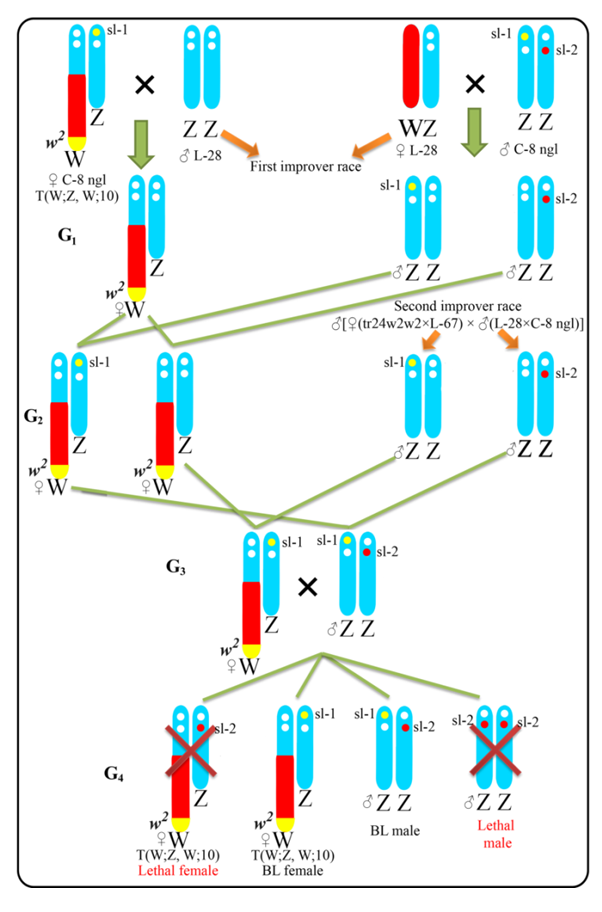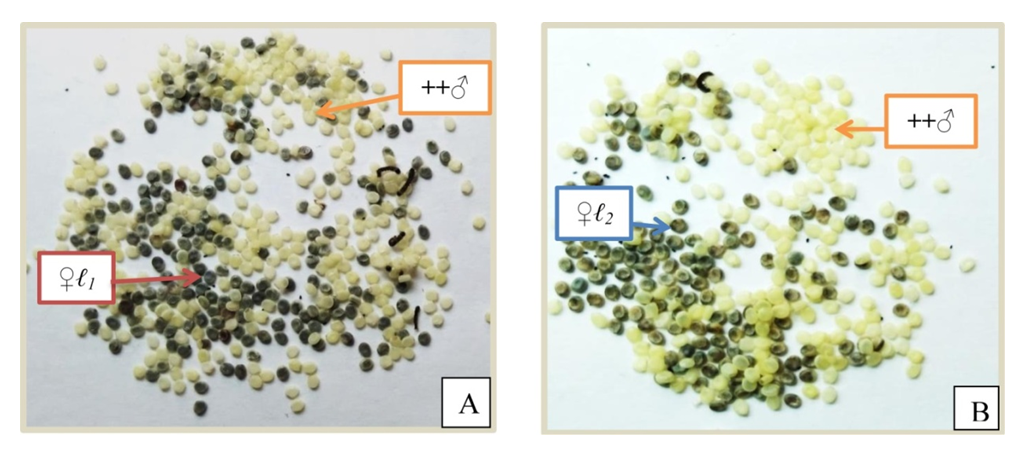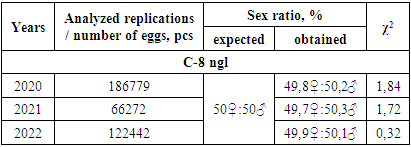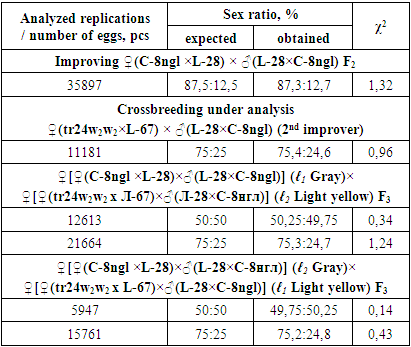-
Paper Information
- Paper Submission
-
Journal Information
- About This Journal
- Editorial Board
- Current Issue
- Archive
- Author Guidelines
- Contact Us
International Journal of Genetic Engineering
p-ISSN: 2167-7239 e-ISSN: 2167-7220
2022; 10(1): 1-4
doi:10.5923/j.ijge.20221001.01
Received: Feb. 3, 2022; Accepted: Feb. 26, 2022; Published: Feb. 28, 2022

The Heritage of Egg Color During the Development of a New Genetic Method of Improvement of Mulberry Silkworm Bombyx Mori L. Balanced Breed with Embryonic Z-Lethalities
Bakhtiyar U. Nasirillaev1, Murodkhuja A. Abdikodirov2
1Head of the Laboratory of Silkworm Breeding, Doctor of Agricultural Sciences Uzbek Research Institute of Sericulture, Tashkent, Uzbekistan
2Department of Genetics, Faculty of Biology, National University of Uzbekistan, Tashkent, Uzbekistan
Correspondence to: Bakhtiyar U. Nasirillaev, Head of the Laboratory of Silkworm Breeding, Doctor of Agricultural Sciences Uzbek Research Institute of Sericulture, Tashkent, Uzbekistan.
| Email: |  |
Copyright © 2022 The Author(s). Published by Scientific & Academic Publishing.
This work is licensed under the Creative Commons Attribution International License (CC BY).
http://creativecommons.org/licenses/by/4.0/

The mulberry silkworm Bombyx mori L. is one of the insects that has been domesticated and used for its own needs for 5,000 years. A mulberry silkworm is a convenient object of scientific research due to its feeding, care, and rapid reproduction. In our study, the rare С-8ngl (NGL - new genetic line) strain of Bombyx Mori L. mulberry silkworm was observed during ovulation, balanced by nonallelic embryonic Z-lethalities, gradually becoming F2 and F3 with simple silk fiber simple genetic lines. Improvements are reflected in the results. The balance of ℓ1 and ℓ2 embryonic non-allelic lethal attached to the Z chromosome in generations F1, F2, and F3 were analyzed to determine the extent to which they manifested in each generation. In each generation, the ratio of females to males was strictly controlled during the ovulation period. The results showed that in the F1, F2, and F3 generations, the egg ratio was balanced from 67♀:33♂ to 50♀:50♂. The theoretically expected results proved to be almost consistent with the practical results obtained by the χ2 statistical calculation method. It follows that the correct formation of the sex ratio in each generation during С-8ngl breeding leads to the stabilization of the embryonic nonallelic lethal balance of the new genetic line obtained. Genetic schemes have been developed to show the extent to which ℓ1 and ℓ2 embryonic lethalities attached to the Z-chromosome in F1, F2, F3, and F4 progeny from bacross crossbreeding are present in each generation. By the F4 generation, balancing of embryonic nonallelic genes in the selection system has been achieved.
Keywords: Mulberry silkworm, Breed, Genetic line, Embryonic Z-lethality, Crossbreeding, Sex labeled, Translocation
Cite this paper: Bakhtiyar U. Nasirillaev, Murodkhuja A. Abdikodirov, The Heritage of Egg Color During the Development of a New Genetic Method of Improvement of Mulberry Silkworm Bombyx Mori L. Balanced Breed with Embryonic Z-Lethalities, International Journal of Genetic Engineering, Vol. 10 No. 1, 2022, pp. 1-4. doi: 10.5923/j.ijge.20221001.01.
Article Outline
1. Introduction
- Mulberry silkworm Bombyx mori L. has been domesticating it for 5,000 years and using it for its own needs. A mulberry silkworm is a convenient object for research due to its feeding, care, and rapid reproduction. Therefore, in this poikilotherm and monophagous insect, several very important problems of genetics have been solved. In particular, the laws of artificial control of sex, experimental (radiation) mutagenesis, a new interpretation of heterosis, and the genetics of quantitative traits were first discovered in mulberry silkworms and the results achieved were directly put into practice.It is well known that mutations are mainly events that directly affect an organism as a result of a complete or partial change (disruption) of its genetic data set. V.A. Strunnikov was one of the first in his research to study the possibility of using lethal mutations in sericulture in the 1960s [1].Currently, artificially controlled sex is only partially used in practice. The problem with their low egg production is the low cost of breeding them. However, silk fibers from male cocoons are thinner and more durable than those from female cocoons [2].We know that mutations are mainly events that directly affect an organism as a result of a complete or partial change (disruption) of its genetic data set. In sericulture, lethal mutations are mainly used to produce male progeny. The lethal period is a series of stages that occur during the G2 period before body pigmentation and mitosis [3], [4].The occurrence and quantity of lethality depend on the strength (dose) of mutagens and the tendency of gametes to mutate (mutability), as well as the success of sex-linked lethality in the number of families and the number of larvae raised from them. Although many mutations can be caused by high doses of radiation, mutants are difficult to detect due to their extremely low viability [5].Sex-linked balanced lethal (SLBL) lines solve the problem of producing only male hybrid progeny, which has an invaluable role in improving silk quality and production efficiency.At the suggestion of Academician V.A. Strunnikov, the procedure for obtaining such series is determined as follows:Induction of W and Z chromosomal translocation processes;Induction of a recessive mutation attached to the Z chromosome that compensates for the dominant allele transferred to the W chromosome (Figure 1) [6].
2. Material and Method
- The experiments were conducted by scientists from the Uzbek Scientific Research Institute of Sericulture under the Committee for the Development of Silk and Wool Industry and the Department of Genetics of the National University of Uzbekistan. In the experiment, the mulberry silkworm Bombyx mori L. used C-8 ngl, a sex-marked, embryonic Z-lethal equilibrium, the sex-marked trw2w2 × L-67, as well as the normal sex-unmarked L-28 lines.The worms selected for the experiment were kept at a young age at a temperature of 26-27°C and relative humidity of 70-75%, and adult worms at a temperature of 24-25°C and relative humidity of 65-70% in special larvae of the Uzbek Scientific Research Institute of Sericulture. 1000 kg of mulberry leaves is used for 1 box of worms. The worms were fed with mulberry leaves of Jarariq 4, Jarariq 5, and Jarariq 6 mulberry varieties. The χ2 method was used to mathematically and statistically evaluate the data obtained and expected in the experiment.
3. Results and Discussion
- This is the first time that the С-8ngl strain-improving method, which labels gender development and is balanced by embryonic lethality, is being used for the first time as an improver for two high-productive strains and as a marker for the egg color +w2 gene on chromosome 10th. Previously, the Japanese scientist A. Ohnuma used the Chinese breed as a donor-improver, as a marker for the pM gene on the 2nd autosomal chromosome - the skin of the worm [7]. According to this method, the morphological marker attached to the sex is mottled on the body of the worm, the worms appear at the age of 3-4 years, and it is more labor-intensive to determine the sex. Genetic marking of eggs by the genetic method we developed allows the identification of lethal genes at an early stage of embryonic development, as well as significant labor and cost savings (Figure 2).
 | Figure 2. A new genetic scheme for breeding that is balanced by embryonic Z-lethalities and sex is marked during the egg stage (via the + w2 gene) |
|
|
4. Conclusions
- Today, the development of the silk industry places high demands on the quality of mulberry silkworm silk fiber. It turns out that high-strength, thin silk is obtained from male cocoons. To create male industrial hybrids, embryonic lethal genetically balanced progeny are required. Therefore, the need and demand for the genotype of new breeds (hybrids) are always high when obtaining high-quality silk. It should be noted that the unique C-8 ngl breed has not been involved in any improvements since its inception. In the future, the task is to bring this breed of silk to the level of the highest quality type 3A - 5A. There is, of course, a need for effective improvement along the way. This method can be used not only in Uzbekistan but also by scientists from leading silkworm countries. Our study showed that the F2 and F3 progeny obtained to improve the С-8ngl breed balanced by double lethality were very close to the theoretically expected separation in egg color. The results were significant in that if the separation differed significantly from the theoretical ratio or was completely different, it could be concluded that the experiments were performed with great error. However, the digital data show that the work is moving in the right direction.
ACKNOWLEDGMENTS
- We are grateful to S.S Lezhenko, Doctor of Biological Sciences, for his advice and assistance to complete our research methodologically correct and selecting experimental materials.
 Abstract
Abstract Reference
Reference Full-Text PDF
Full-Text PDF Full-text HTML
Full-text HTML

